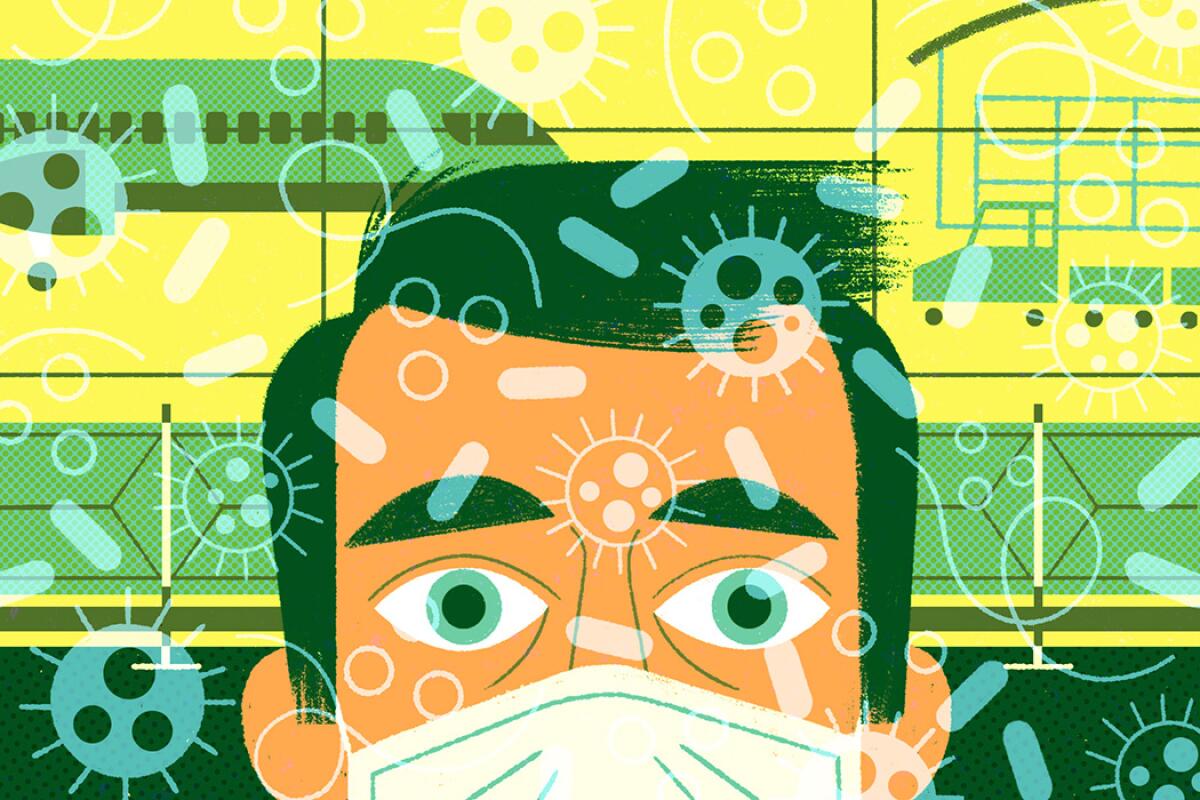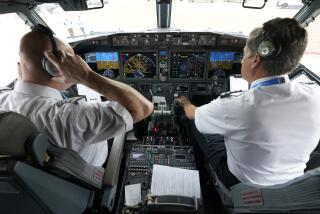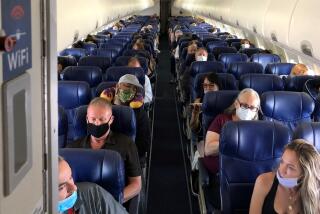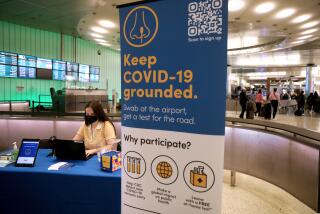Flight attendants’ jobs are dangerous — to their health. The problem: you

Airplanes make me sick.
To be more precise, the passengers who cough, sneeze, wheeze and use bare hands to wipe the edges of their mouths, then manipulate seat-back touchscreens and lavatory toilet flush buttons make me sick.
They make you sick too. And when you and I fall ill, most anyone we come into contact with is susceptible to our illness.
As the highly contagious coronavirus continues to spread, the U.S. airline I work for has adopted measures to help prevent in-flight infection:
- All flights to/from mainland China and Hong Kong have been suspended through April 24. (The flight suspensions are because of a drop in demand.)
- Flight attendants working routes to Australia, New Zealand and all destinations in Asia have been granted permission to wear face masks aboard the aircraft.
- On all flights crossing the Pacific, the airline will begin providing hand sanitizer for crew members and sanitizing wipes for passengers.
These efforts may help calm nerves and prevent the spread of the virus.
But the rapid spread of the virus and the resulting medical crisis bring to light an unmistakable truth about air travel:
It’s a filthy undertaking.
A study by InsuranceQuotes.com hammers home the point. The company tested surfaces at major airports and on select flights. Swabs were sent to a laboratory to determine “the average number of viable bacteria and fungal cells per square inch, or colony-forming units (CFU).” The results were compared with bacteria found on common household surfaces.
Self-service check-in screens were the dirtiest surface at an airport. The average screen recorded 253,857 CFU, which translates to 12 times as many contaminants as on a typical kitchen sink (21,000 CFU). The tests revealed that one filthy check-in screen harbored more than 1 million CFU. By comparison, the average household toilet seat registers 172 CFU.
While waiting for a flight in the departure lounge, you’re likely to come into contact with the second grimiest spot at an airport: Armrests at a gate bench seat harbor more than 100 times the bacteria found on your bathroom doorknob.
Once you board the aircraft, consider the lavatory’s toilet flush button. Better yet, consider grabbing a tissue before pressing the lavatory’s toilet flush button. On any given flight, this essential apparatus might be pressed hundreds of times by people who practice varying levels of personal hygiene. The typical flush button scored 95,145 CFU. That’s 260 times more contamination than the nastiest area in your home — the kitchen counter.
The average airline tray table is 32 times dirtier than your kitchen countertop. The seat belt buckle contains 37 times more bacteria than your toilet flush handle. The seat-back touch screen — on which countless folks have hunted and pecked with greasy, lip-licked fingertips — can make in-flight video entertainment as unsanitary as the self-service screen you may have used to check in at the airport.
These affected surfaces can harbor a variety of bacteria and fungi.
I’ve worked as a flight attendant for nearly 35 years. On most of my 7,000-plus flights, at least one passenger has coughed repeatedly or sneezed uncontrollably or honked something into a dirty handkerchief.
And then there’s vomit. During turbulent flights, it’s not uncommon for a passenger to get sick. Flight attendants face the unenviable task of cleaning up the mess. If the ailing person suffers from a particular norovirus such as food poisoning, we risk exposing ourselves to the highly contagious ejecta.
Add to that the fact that an airplane cabin has notoriously poor air circulation and it’s no wonder my doctor told me, “I’m surprised you don’t get sick more often.” He said this after my third upper respiratory tract infection last year.
Off the plane, I lead a healthy lifestyle. I don’t smoke. I drink very little alcohol. I eat low-calorie meals and work out in a gym at least four days each week.
But no matter how often I wash my hands during a flight, no matter how frequently I tell myself not to rub my eyes or touch my lips after handling dirty utensils, close contact with airline passengers makes me susceptible to acute bronchitis, the common cold, influenza and laryngitis, all of which I experience semiregularly.
Perhaps this is to be expected for someone who works in a flying petri dish.
Even so, my employer recognizes the issue. Well, sort of. Long before coronavirus raised its ugly head, the airline allowed flight attendants to wear latex gloves for protection — but only when serving passengers in the main cabin. The use of gloves has long been forbidden in first- and business-class cabins.
Might the airline’s justification is that premium passengers were incapable of spreading germs? Of course not. Instead, the airline believed latex glove-wearing crew members were an insult to a privileged few.
Truth be told, gloves might protect the privileged from me.
More to Read
Sign up for The Wild
We’ll help you find the best places to hike, bike and run, as well as the perfect silent spots for meditation and yoga.
You may occasionally receive promotional content from the Los Angeles Times.






